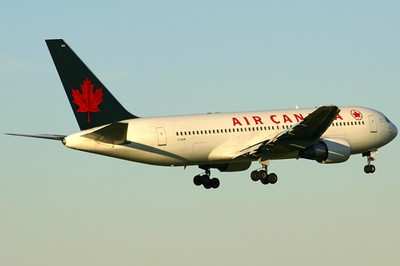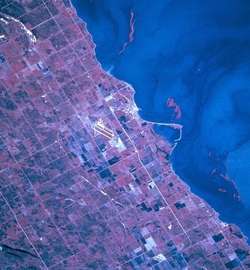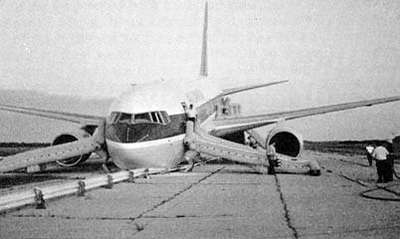C-GAUN Heads To Retirement In Arizona
To most passengers, no doubt, she was little more than a
run-of-the-mill widebody airliner. Few would probably realize she
was, in fact, a Boeing 767... and a somewhat tired one at that.
Fewer still likely recognized the proud, but also infamous part she
played in the history of modern commercial airline travel.

Those who did realize what was special about C-GAUN, though --
including many employees with Air Canada -- gathered Thursday to
bid farewell to the old bird... better known by its nickname, the
'Gimli Glider.' It was nearly 25 years ago the discovery of a
problem with part of the aircraft's flight management system kicked
off a sequence of events, that resulted in a commercial airliner
successfully imitating a glider.
Maintenance crews checking C-GAUN on July 23, 1983 discovered
faulty soldering had knocked out the aircraft's Fuel Quantity
Indicator System (FQIS), reports Canada's National Post. Instead of
grounding Air Canada Flight 143 from Montreal to Edmonton, via
Ottawa... they instead chose to perform fueling calculations
manually, though none of them had been trained to do so.
 Crews triple-checked
their numbers, and submitted that data to the plane's flight crew
-- Captain Robert Pearson, and First Officer Maurice Quintal, who
rechecked the numbers using an incorrect conversion method. Ground
crews used imperial measurements to compute the 767's fuel load,
instead of metric figures. Canada was in the process of converting
to metrics, and the Air Canada 767 was one of the first planes in
the fleet set up with the new system.
Crews triple-checked
their numbers, and submitted that data to the plane's flight crew
-- Captain Robert Pearson, and First Officer Maurice Quintal, who
rechecked the numbers using an incorrect conversion method. Ground
crews used imperial measurements to compute the 767's fuel load,
instead of metric figures. Canada was in the process of converting
to metrics, and the Air Canada 767 was one of the first planes in
the fleet set up with the new system.
Though still somewhat uncertain of their figures, when the
ground crews received word of the plane's safe arrival in Ottawa,
they felt reassured. That feeling wouldn't last... as over Red
Lake, Ontario, a warning signal in the plane's cockpit sounded, and
the flight crew realized the error.
One engine failed, followed soon by the second. As electrical
power is generated from the turbofans, the aircraft's glass-panel
avionics soon failed as well, after reserve battery power ran out.
That left the flight crew with a powerless bird, with only a
handful of mechanical backup instruments and unboosted flight
surface controls to keep the plane right-side up, and descending at
2,000 feet-per-minute.
It was here that fate, religion, or serendipity kicked in.
Captain Pearson was an expert glider pilot... and while the crew
had no hope of keeping the plane in the air all the way to
Winnipeg, First Officer Quintal knew of an abandoned Air Force base
along their flight path -- in Gimli, Manitoba -- where he had once
served.
Using the limited instruments to compute the 767's best-glide
speed, Pearson successfully glided the plane to the runway at
Gimli... where the crew discovered, to their horror, spectators and
campers were spread out, to watch go-cart races at the abandoned
field. At that point, however, they were committed.
Following a hard landing, in which the plane's nosegear
collapsed, the plane came to a stop 100 feet from where spectators
had run to, having seen the plane on approach. There were no
injuries on the ground, nor to the 61 passengers onboard the
plane.

Though both Pearson and Quintal were chastised by Air Canada --
as were three maintenance workers -- for failing to follow proper
procedure regarding the inoperative fuel computer, which was
technically a no-fly item... both pilots remained with the carrier,
and in 1985 received the first-ever Fédération
Aéronautique Internationale Diploma for Outstanding
Airmanship.
Pearson, Quintal, and other crewmembers from that fateful flight
were onhand Thursday morning, as C-GAUN took off on what likely
will be the aircraft's final flight, to a boneyard in Tucson, AZ...
an ignoble end to a once-proud lady of the skies.
 Aero-FAQ: Dave Juwel's Aviation Marketing Stories -- ITBOA BNITBOB
Aero-FAQ: Dave Juwel's Aviation Marketing Stories -- ITBOA BNITBOB NTSB Prelim: Rutan Long-EZ
NTSB Prelim: Rutan Long-EZ ANN's Daily Aero-Term (12.05.25): Hazardous Weather Information
ANN's Daily Aero-Term (12.05.25): Hazardous Weather Information Aero-News: Quote of the Day (12.05.25)
Aero-News: Quote of the Day (12.05.25) Airborne-Flight Training 12.04.25: Ldg Fee Danger, Av Mental Health, PC-7 MKX
Airborne-Flight Training 12.04.25: Ldg Fee Danger, Av Mental Health, PC-7 MKX





